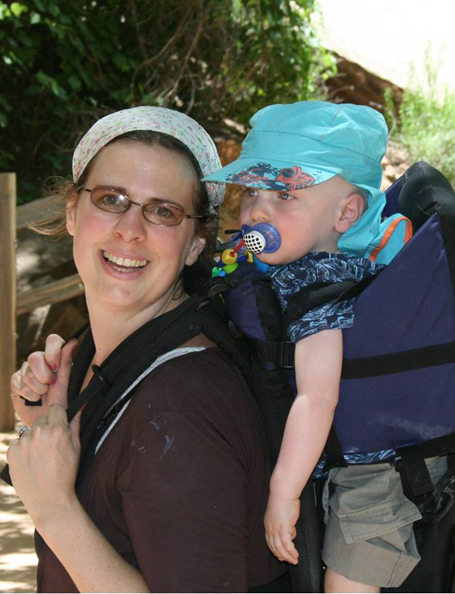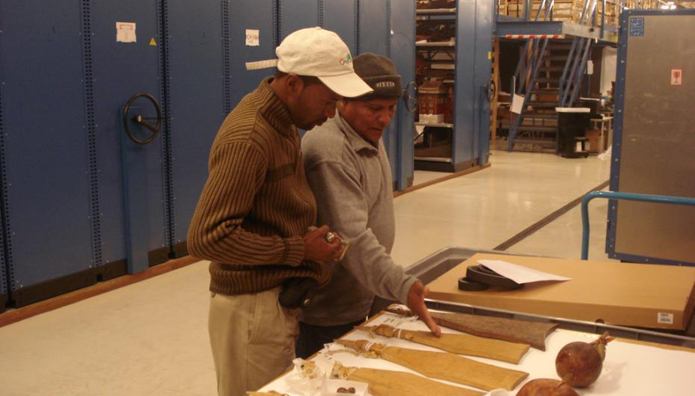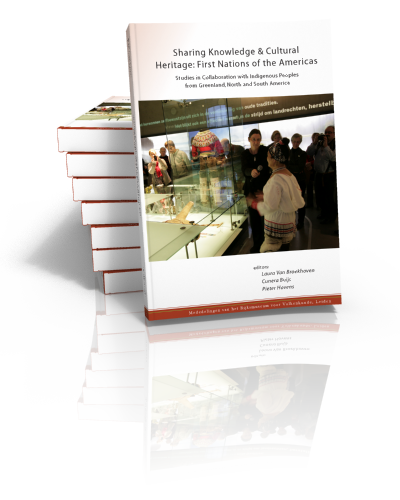 Teresa Morales en Chris Keulemans bij Cultural Heritage and Shared Knowledge. Foto: Diederik Paauwe / Framer Framed
Teresa Morales en Chris Keulemans bij Cultural Heritage and Shared Knowledge. Foto: Diederik Paauwe / Framer Framed Report: Cultural Heritage and Shared Knowledge
On November 7, 2010, Framer Framed assembled a diverse international panel of experts in De Balie in Amsterdam. Different and innovative approaches to cultural heritage were presented both in real life and on Skype from all corners of the world. Whether it was South America, Africa or Asia, the approaches shared one common trait: all are first concerned with the ‘owners’ of the cultural heritage and second with its material or ‘Western’ value.
Teresa Morales started of by introducing the theory of New Museology, which is still unknown to most museum and heritage professionals in the Netherlands. This ideology emerged already in 1962 and has been advocating that museums ‘become a true community service’. The museum is no longer an institution that dictates its definition of culture from above, but a place for dialogue within the community. From her own experience, Morales told us about the network of community museums in Oaxaca, Mexico. Faced with globalization and the threat of losing their heritage, the communities were interested in creating a community museum. In the museum they preserve both material culture and the important rituals and customs that define their cultural identity. With the museum experts like Morales acting as facilitators, decisions were made in the community. Now, the museums are successfully run by the community for the long-term.
Adding an example of realizing a museum in collaboration with the community, Vânia Brayner, general director of Museu do Homem Nordeste spoke about making a museum of the people, instead of about the people. The Museum of North-Eastern Man in Brazil has had the challenge to change a governmental institution into a museum that is representative of all the diverse and different Men of the North-Eastern Region of Brazil. By bringing stories of social conflict and daring installations into the museum it no longer represents the stereotypical Other but the real people of this enormous region. With social museology as a theoretical framework, Maria Fernanda Pinheiro de Oliveira added that the museum also goes into communities where they symbolically hand over the museum. By engaging in dialogue with the community, cultural heritage is shared and the museum becomes part of the collective identity in the community.
With so many speakers we quickly went on to another story from Latin America. Silvia Karolina Acuña Aviles talked to us on Skype from Nicaragua. There, the Solentiname museum exhibits the culture and the unique ecosystem of the Solentiname Islands. From the establishment of the museum, the community of farmers was involved in doing research for exhibits, making beautiful artworks representing the flora and fauna of the islands, and decision-making about the museum. A members committee has been organized and the museum takes its place at the heart of the community of Solentiname islands. Funds are received from different organizations but the Foundation MUSE runs the museum for the long-term.
For projects like these in Latin America, modern ways of communication give excellent possibilities to promote community projects and create solidarity and support between countries. Through websites and forums communities and experts alike can benefit from each other’s knowledge. According to Teresa Morales, the lesson to learn for heritage professionals is how to teach skills so communities can run their museum in the long run.
The question remains whether the theory and practice of New Museology functions only in the context of Latin America. A history of social movements and communities with a strong identity makes it fertile ground for new museology. But does this theory of social museology work in Africa and Asia as well?
Ziva Domingos joined the discussion to tell us about new initiatives in Africa. As a heritage professional working with the EPA, an African Training Institution for Heritage he got involved with the amazing story of the Museum of Adjara. How a private collector got convinced that a museum would be the best place to preserve and promote his collection. In Adjara, the museum provides jobs and increases tourism. Furthermore, a partnership with local artists gives space for temporary exhibitions. With room for children’s activities and a restaurant the museum wants to stimulate local economy. Also, cultural activities can stimulate the region’s intangible heritage. In a place where reducing poverty is a major goal, this museum tries to combine economic opportunities with cultural enrichment of the local community and area. As Domingos says in his article about the museum of Adjara: ‘museums should be responsive to the needs of the community and provide an intercultural dialogue.’
From the museum as a contributor to development to heritage as a weapon against political doctrines in Sri Lanka: Jagath Weerasinghe joined from Skype to tell about the project Ape Game. Seventeen artists use the power of art to intervene in the social and political unrest in Sri Lanka. The simple and brilliant activity of asking children to draw a cultural map of their village makes them aware of their collective identity. To counteract the nationalist politics in Sri Lanka the final cultural map also displays where the trees and customs can be found elsewhere in the world, in this way shows the children how their village fits into the rest of the world. Weerasinghe believes in art as a transformative force, in this case to bring back collective memory that is inclusive instead of exclusive. The children are the most receptive to these changes and hopefully will carry on teaching their parents and peers a broader view of the world.
After some technical problems, Patrick Abungu explained the challenges facing the Shimoni Slave Cave in Kenya. A place of contested memory, function and heritage it is difficult to unite a community to preserve and promote this unique place. The different stakeholders include those whose ancestors were sold as slaves as well as those whose ancestors were selling slaves. Although the place of memory is contested, both groups benefit from the exploitation of the cave as a heritage site. Abungu argues that the visitor is actually the owner of this heritage site because he/she determines how it is remembered. For the NMK – National Museums of Kenya it is the challenge to represent the multiple layers of this heritage site whilst stimulating local economy and development. More importantly, involving the community in their cultural heritage will lead to social and political advancements and create a future for a shared heritage site.
When comparing Latin American approaches to cultural heritage and shared knowledge to those in Africa and Asia several things become clear. In this globalized world cultural heritage has become increasingly important as a tool to empower local communities. Whether it is a cultural identity that is strengthened for the future or the economic and political benefits of cultural heritage in the community, the focus of heritage and museums has changed from objects to people in all projects presented. Heritage is no longer owned by elites but is acknowledged as being of vital importance for communities, those who are represented by the heritage.
After all these journeys, the Netherlands was represented by Laura Broekhoven from the National Museum of Ethnology. A traditional museum with an ethnographic collection they now collaborate with peoples like the Inuit in Greenland and Maori in New Zealand. The museum asks representatives from the source communities to form a partnership with the museum, as community curator, who can inform about the handling and meanings of objects, thus creating new narratives that evolve from this dialogue. The power of the institution is shared, the museum no longer in control of knowledge and collection. These projects have led to exhibitions in the museum and in the communities themselves, where they are highly valued. As Broekhoven stated, museums in the Netherlands are looking for new practices with a new focus on dialogue, shared knowledge and mutual capacity building. Slowly the paradigm shift is happening.
This afternoon of interesting stories was unfortunately limited by technology and time. Each story made us curious to learn more and discuss the expert’s experiences more extensively. Despite this lack of time one thing became clear; cultural heritage and shared knowledge, the theory of new museology and the practices all around the world are promising to be the subject of discussions for the coming years.
Continue reading
Abungu, Patrick, O, The power of Memorial Culture: the case of Shimoni historical slave cave in Kenya. Symposium City museums on the Move, 23-24 August 2010 (2010).
Domingos, Ziva. New Trends in Preserving and Promoting African Cultural Heritage, Cultural Institutions and Communities in Africa: The Museum of Adjara (2010).
Morales, Teresa, Community Museums and Global Connections: The Union of Community Museums in Oaxaca. In: Museum Frictions: Public Culture/Global Transformations. Eds: Karp, I. et al. Durham and London, Duke University Press, p. 322-344 (2006).
Pinheiro de Oliveira, Maria Fernanda & Silva de Mello, Ciema, Men Change, and Museums Change. In: Sociomuseology III – Cadernos de Sociomuseologia Vol. 37-2010 (2010).
Laura Van Broekhoven, Cunera Buijs, and Pieter Hovens, eds Sharing Knowledge & Cultural Heritage, First Nations of the Americas, sidestone press (2010).
- Teresa Morales, Ideas on Starting a Community Museum
- COMMUNITY MUSEUMS AND GLOBAL CONNECTIONS
- THE POWER OF MEMORIAL CULTURE
- Men Change and Museums Change, SOCIOMUSEOLOGY III
Attachments
Shared Heritage / Innovative heritage /
Agenda
Cultural Heritage and Shared Knowledge
A panel discussion on the concept and use of cultural heritage.
Network
Patrick Abungu
Curator
Silvia Karolina Acuna Aviles
Social Archaeologist, Art Historian
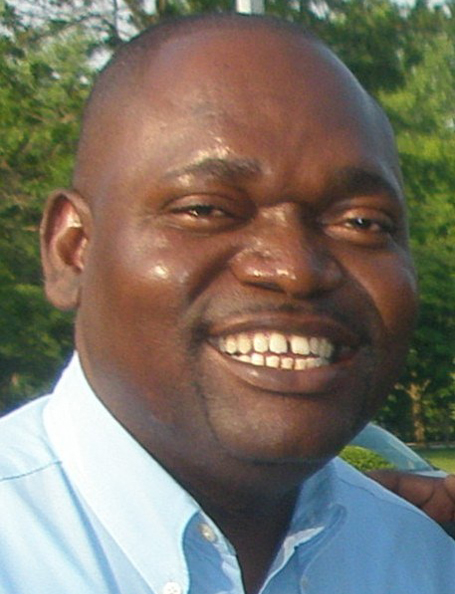
Ziva Domingos
Curator, Lecturer
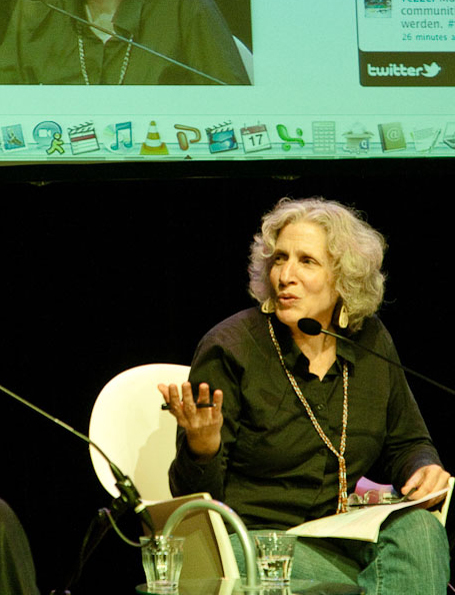
Teresa Morales
Professor
Ciema Silva de Melo
Antropologist
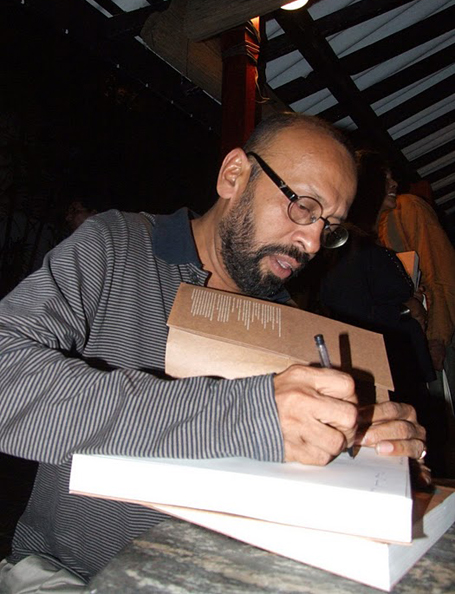
Jagath Weerasinghe
Archaeologist, Artist
